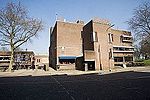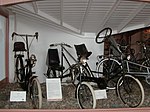Veur-Lent
Veur-Lent is the name of an island in the Dutch river Waal. This city island is part of the municipality of Nijmegen, it is situated in the Lent Quarter, north of the city center. Owing to the threat of dike breaches at high water, it was decided in 1995 that more water would need to flow through the river. Because the sharp bend in the Waal at Nijmegen created a bottleneck and restricted the water flow, a three kilometer long parallel gully, called the Spiegelwaal, was dug at this point. This resulted in the creation of the new island. These activities were started in 2011 and as a result, the water level was lowered by 30 centimeters.Various bridges were built to the island. The island can be reached by foot from the Waalbrug (Waal Bridge), Spoorbrug (Railway Bridge), the Oversteek, the Zaligebrug (Zalige Bridge) and the Lentloper. The latter was built at a later point from the side of Lent. There are plans to build homes and shops on the island in the future. The costs of constructing the island amounted to 350 million euros.
Excerpt from the Wikipedia article Veur-Lent (License: CC BY-SA 3.0, Authors).Veur-Lent
Oosterhoutsedijk, Nijmegen Nijmegen-Noord
Geographical coordinates (GPS) Address Nearby Places Show on map
Geographical coordinates (GPS)
| Latitude | Longitude |
|---|---|
| N 51.8542 ° | E 5.865 ° |
Address
Oosterhoutsedijk 31
6663 KS Nijmegen, Nijmegen-Noord
Gelderland, Netherlands
Open on Google Maps











